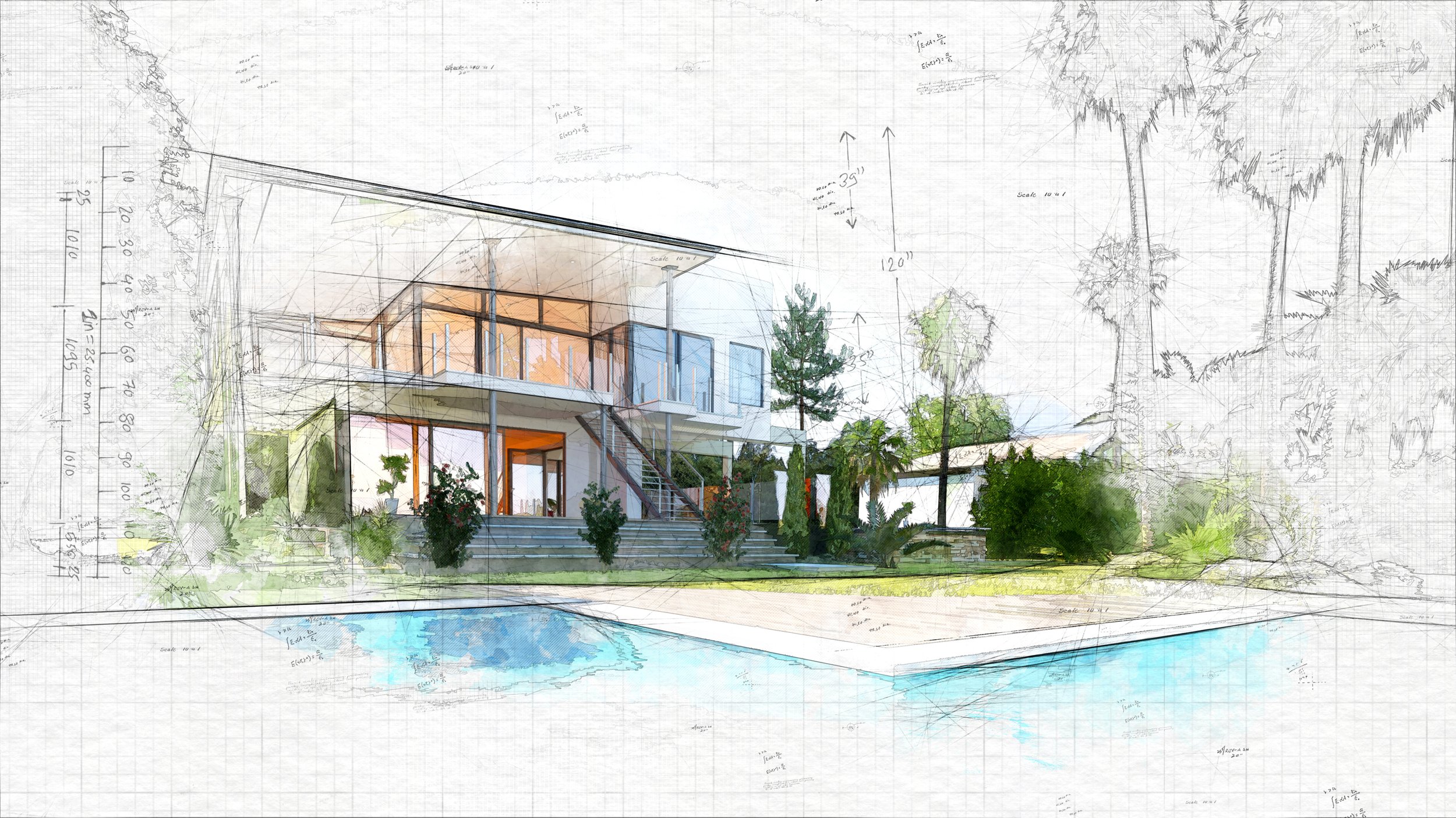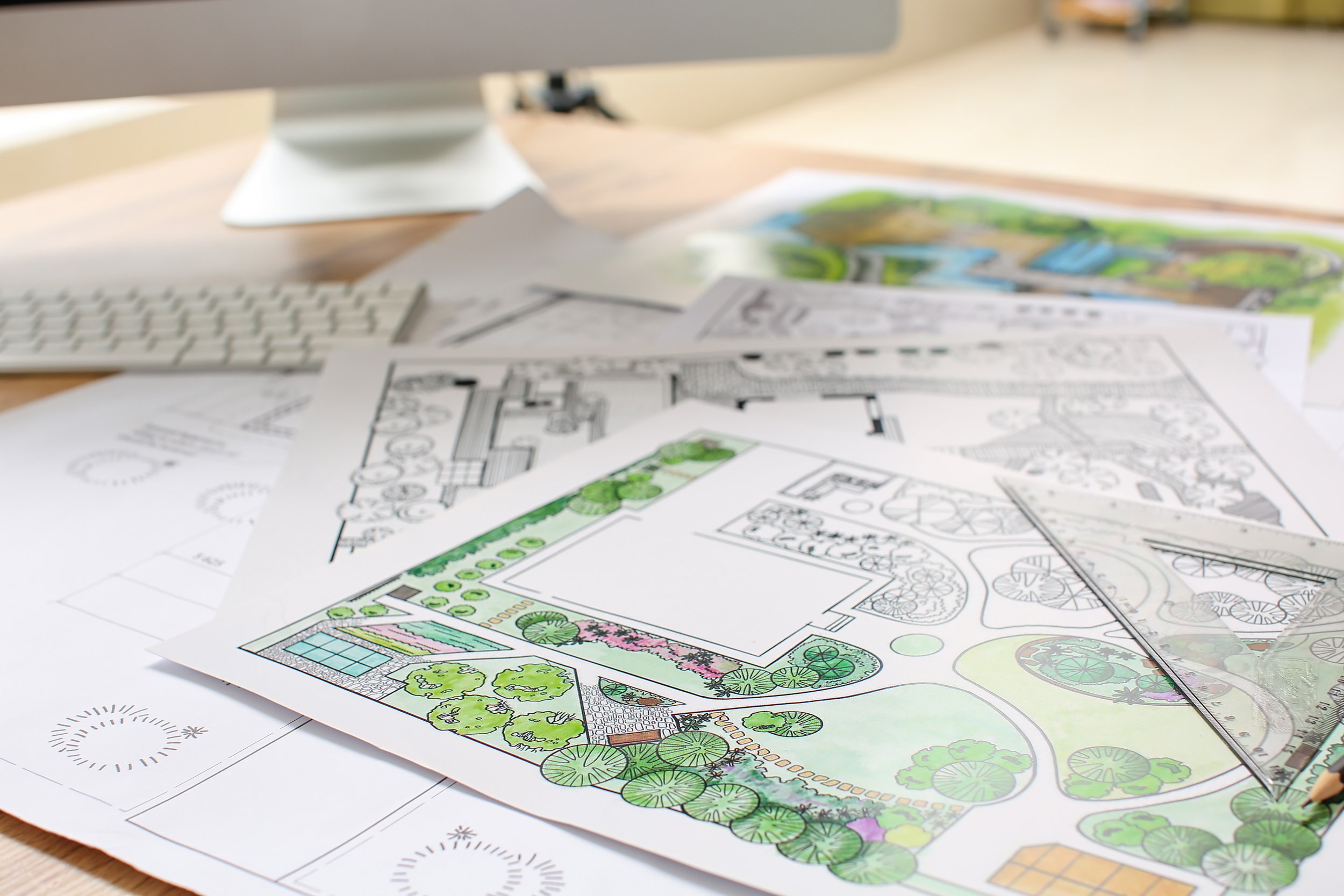
Landscape Design Geometries
-

Rectilinear
A rectilinear design style refers to a design approach that is characterized by the use of straight lines and geometric shapes. In this style, the layout of the garden is based on a grid or a series of interconnected rectangles and squares.
The design is typically symmetrical and balanced, with a clear and defined structure. The elements in the garden, such as paths, beds, and walls, are usually straight and geometric in shape, creating a sense of order and organization.
The use of geometric shapes and straight lines in a rectilinear design can create a sense of formality and elegance, but also can give a more modern and minimalist feel.
This style is often used in formal gardens, courtyards, and city gardens, but it can also be adapted to suit other styles such as contemporary or traditional.
-

Curvilinear
Curvilinear garden design is a style of garden design that is characterized by the use of curved lines and organic shapes. In contrast to rectilinear design, which uses straight lines and geometric shapes, curvilinear design creates a more natural and flowing feel.
The layout of the garden is based on a series of interconnected curves, rather than a grid or rectangles and squares. The elements in the garden, such as paths, beds, and walls, are often curved and may be inspired by natural forms such as waves, streams, or undulating hills.
This style of garden design creates a sense of movement and fluidity, and can feel more relaxed and informal than a rectilinear design. Curvilinear design can be seen in many different types of gardens such as country, cottage, and naturalistic gardens.
-

Symmetrical
A symmetrical garden style is a type of garden design that is characterized by the use of symmetry and balance. In this style, the layout of the garden is based on a central axis, with elements on either side of the axis mirroring each other. The design is often very formal, with a clear and defined structure. The elements in the garden, such as paths, beds, and walls, are usually symmetrical and balanced, creating a sense of order and organization. Symmetry is often used to create a sense of formality and elegance, and it is often used in traditional and formal gardens.
In a symmetrical garden, paths, lawns, and other features are often placed so that they bisect the garden, with one half of the garden being a mirror image of the other. Elements such as statues, fountains, and other garden ornaments are often placed along the central axis to further emphasize the symmetry. The choice of plants and their placement also follows the symmetrical pattern.
It is important to note that the symmetrical design doesn't have to be a mirror image, it could also be a radial symmetry where all elements radiate out from a central point.
-

Asymmetrical
An asymmetrical garden style is a type of garden design that is characterized by the lack of symmetry and balance. In this style, the layout of the garden does not follow a central axis, and the elements in the garden are not mirror images of each other. Instead, the design is more natural and informal, with a less defined structure. The elements in the garden, such as paths, beds, and walls, are often irregular and may be inspired by natural forms such as undulating hills or rock outcroppings.
In an asymmetrical garden, paths, lawns, and other features are often placed in a more random or naturalistic way, without a clear central axis or mirroring of elements. Elements such as statues, fountains, and other garden ornaments are often placed in unexpected or irregular locations to further emphasize the asymmetry. The choice of plants and their placement also follows an irregular pattern, creating a sense of movement and fluidity.
An asymmetrical garden style can be seen in many different types of gardens such as naturalistic, country, and contemporary gardens. It gives the garden a more relaxed and informal feel and allows for a more creative and artistic approach to garden design.
-

Layered Geometries
A layered geometric design style in landscape architecture is a type of garden design that is characterized by the use of multiple layers of geometric shapes and forms. This design style creates a sense of depth and complexity by layering different elements on top of each other, rather than having them all at the same level.
In this style, geometric shapes such as circles, squares, and rectangles are often used to define different areas of the garden. Each layer of the design can be composed of different materials, colors, or textures, creating a sense of depth and contrast. For example, a geometric patio might be overlaid with a geometric trellis, or a geometric pool might be surrounded by geometric beds of plants.
The use of geometric shapes and forms in a layered design can create a sense of formality and elegance, but also can give a more modern and minimalist feel. This style is often used in formal gardens, courtyards, and city gardens but can also be adapted to suit other styles such as contemporary or traditional. This style can be seen in different types of gardens, such as public spaces, residential gardens, and commercial landscapes.
-

Hybrid Geometric
A hybrid geometric garden is a type of garden design that combines elements of both rectilinear and curvilinear design styles. In a hybrid geometric garden, straight lines and geometric shapes are used in combination with curved lines and organic shapes. This creates a unique and dynamic design that combines the sense of order and organization of a rectilinear garden with the sense of movement and fluidity of a curvilinear garden.
In a hybrid geometric garden, elements such as paths, beds, and walls are often a combination of straight and curved lines, and geometric shapes such as circles, squares, and rectangles are used in combination with natural forms such as undulating hills or rock outcroppings. The use of both straight and curved lines can create a sense of tension and movement in the garden, making it more interesting and dynamic. The choice of plants and their placement also follows a combination of patterns, creating a sense of balance and harmony.
This style of garden design is often used to create a sense of surprise, interest and mystery. It can be seen in different types of gardens, such as public spaces, residential gardens, and commercial landscapes. It allows for a more creative and artistic approach to garden design and can be used to create a unique and visually striking garden.

Green City is a subsidiary of Spaces Design Build, specializing in outdoor living spaces, interior landscapes, architecture, and interior design, with projects spanning the United States and countries around the world.
